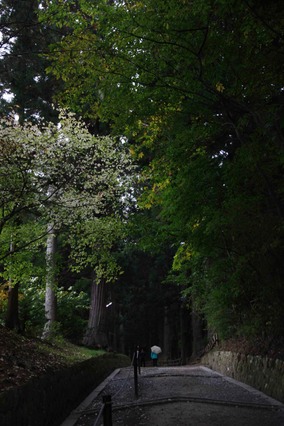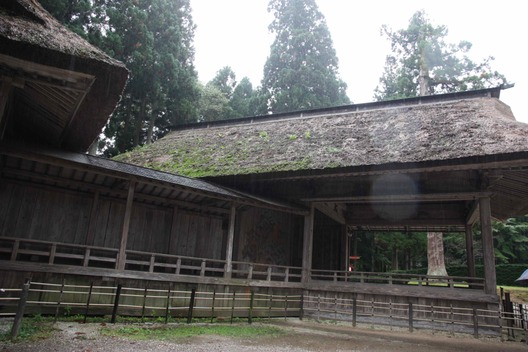
It was the contrast between the former glory and contemporary reality that prompted the desire to visit somewhere and take a look around a few places where there didn't seem that much to actually see.
But, first, there was Chuson-ji.
We arrived in the car park to find the place close to checkers with not one, not two, but three baton-wielding traffic wardens guiding the incoming flow of cars and buses into appropriate slots in the parking area.
Wandering over to the entrance, we were expecting to pay the regulation couple of hundred yen to get in (nominal fee to fund maintenance and upkeep) and, surprisingly, none was asked for, though we did receive a fairly flash English language leaflet describing the town's main attractions.
We made our way up the hill, through a magnificent avenue of ancient trees, passing a variety of smaller structures.
Apart from its status as Hiraizumi's most famous temple, Chūson-ji serves as the head temple of the Tendai sect in Tōhoku, but it is best known for its Golden Hall (Konjikidō), a mausoleum that contains the mummified remains of the leaders of the clan who ruled the region in its 12th century heyday.
The Tendai sect claims the temple was founded in 850 by Ennin, but most scholars believe Chūson-ji was founded around 1100 since there is no archaeological or historical record of Buddhist activity in this area before that time.
Similar to Kyoto's Kinkakuji (Golden Pavilion), the Konjikido is a hall completely covered in gold, dates back to 1124, one of two buildings that survive from the original complex. The other is the Kyozo Hall, which served as a repository for sutra (Buddhist scripture). While not nearly as impressive as the gilded Konjikido, it predates that building by 16 years.

The Konjikido originally sat in the open air, but successive measures to protect it from the elements saw it housed inside a wooden building that still stands on the site today, and subsequently moved inside a purpose built concrete building behind thick glass so that it's now only visible from the front.
Dedicated to Amida Nyorai (the Buddha of Infinite Light) the structure, which measures five-and-a-half metres on the sides and stands eight metres high, contains altars for each of the first three Fujiwara lords. Apart from the roof, the whole thing is covered with gold leaf, decorated with golden lacquer and mother-of-pearl, and studded with gold and silver, with three Buddha images.